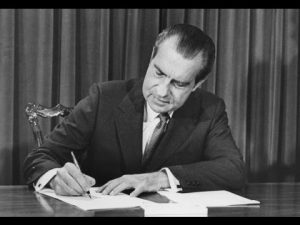The DEA announces that it has arrested 280 people, including 22 doctors and pharmacists, after a 15 month sting operation centered on health care providers who dispense large amounts of opioids. The sting, dubbed Operation Pilluted, is the largest prescription drug bust in the history of the DEA.
Category: Opioid Class
2010- FDA approves “abuse deterrent” version of Oxycontin
FDA approves an “abuse deterrent” formulation of OxyContin, to help curb abuse. However, people still find ways to abuse it.
2007- Purdue Pharma charged with misleading advertising for Oxycontin
The federal government brings criminal charges against Purdue Pharma for misleadingly advertising OxyContin as safer and less addictive than other opioids. The company and three executives are charged with “misleading and defrauding physicians and consumers.” Purdue Pharma and the executives plead guilty, agreeing to pay a $634.5 million in criminal and civil fines. The three executives plead guilty on criminal misdemeanor charges and are later sentenced to probation.
2017- June: FDA asks Endo to remove Opana ER from U.S. market

In June 2017, the FDA asked the manufacturer to remove its injectable form of oxymorphone (Opana ER) from the US market, because the drug’s benefits may no longer outweigh its risks, this being the first time the agency has asked to remove a currently marketed opioid pain medication from sale due to public health consequences of abuse.
From the press release-
Today, the U.S. Food and Drug Administration requested that Endo Pharmaceuticals remove its opioid pain medication, reformulated Opana ER (oxymorphone hydrochloride), from the market. After careful consideration, the agency is seeking removal based on its concern that the benefits of the drug may no longer outweigh its risks. This is the first time the agency has taken steps to remove a currently marketed opioid pain medication from sale due to the public health consequences of abuse.
“We are facing an opioid epidemic – a public health crisis, and we must take all necessary steps to reduce the scope of opioid misuse and abuse,” said FDA Commissioner Scott Gottlieb, M.D. “We will continue to take regulatory steps when we see situations where an opioid product’s risks outweigh its benefits, not only for its intended patient population but also in regard to its potential for misuse and abuse.”
The FDA’s decision is based on a review of all available postmarketing data, which demonstrated a significant shift in the route of abuse of Opana ER from nasal to injection following the product’s reformulation. Injection abuse of reformulated Opana ER has been associated with a serious outbreak of HIV and hepatitis C, as well as cases of a serious blood disorder (thrombotic microangiopathy). This decision follows a March 2017 FDA advisory committee meeting where a group of independent experts voted 18-8 that the benefits of reformulated Opana ER no longer outweigh its risks.
Opana ER was first approved in 2006 for the management of moderate-to-severe pain when a continuous, around-the-clock opioid analgesic is needed for an extended period of time. In 2012, Endo replaced the original formulation of Opana ER with a new formulation intended to make the drug resistant to physical and chemical manipulation for abuse by snorting or injecting. While the product met the regulatory standards for approval, the FDA determined that the data did not show that the reformulation could be expected to meaningfully reduce abuse and declined the company’s request to include labeling describing potentially abuse-deterrent properties for Opana ER. Now, with more information about the risks of the reformulated product, the agency is taking steps to remove the reformulated Opana ER from the market.
2012- Canada removes OxyContin from drug formulary

OxyContin was removed from the Canadian drug formulary in 2012.
2010- Purdue reformulates OxyContin to make it harder to crush

In 2010, Purdue Pharma had reformulated OxyContin, using a polymer to make the pills extremely difficult to crush or dissolve in water to reduce OxyContin abuse. OxyContin use following the 2010 reformulation declined slightly while no changes were observed in the use of other opioids.
1995- OxyContin enters the US market
OxyContin, a long acting version of oxycodone, which slowly releases the drug over 12 hours, is introduced and aggressively marketed as a safer pain pill by manufacturer, Purdue Pharma. The FDA approved relabeling the reformulated version as abuse-resistant. However, drug users quickly learned how to simply crush the controlled release tablet to swallow, inhale, or inject the high-strength opioid for a powerful morphine-like high. In fact, Purdue’s private testing conducted in 1995 determined that 68% of the oxycodone could be extracted from an OxyContin tablet when crushed.
1980- January 10th NEJM Article- “”Addiction Rare in Patients Treated with Narcotics”
A letter titled “Addiction Rare in Patients Treated with Narcotics” is published in the New England Journal of Medicine. It was not a study and looked at incidences of addiction in a very specific population of hospitalized patients who were closely monitored. However, it would become widely cited as proof that narcotics were a safe treatment for chronic pain.
1970- The Controlled Substances Act

The Controlled Substances Act becomes law. It creates groupings (or schedules) of drugs based on the potential for abuse. Heroin is a Schedule I drug while morphine, fentanyl, oxycodone (Percocet, OxyContin) and methadone are Schedule II. Vicodin
1970s- FDA classifies oxycodone as Schedule II drug

In the 1970s, the FDA classified oxycodone as a Schedule II drug, indicating a high potential for abuse and addiction.
